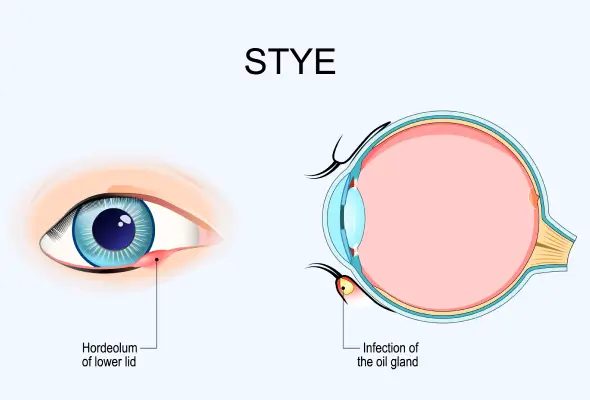-
Doctors
-
Specialities & Treatments
Centre of Excellence
Specialties
Treatments and Procedures
Hospitals & Directions HyderabadCARE Hospitals, Banjara Hills CARE Outpatient Centre, Banjara Hills CARE Hospitals, HITEC City CARE Hospitals, Nampally Gurunanak CARE Hospitals, Musheerabad CARE Hospitals Outpatient Centre, HITEC City CARE Hospitals, Malakpet
HyderabadCARE Hospitals, Banjara Hills CARE Outpatient Centre, Banjara Hills CARE Hospitals, HITEC City CARE Hospitals, Nampally Gurunanak CARE Hospitals, Musheerabad CARE Hospitals Outpatient Centre, HITEC City CARE Hospitals, Malakpet Raipur
Raipur
 Bhubaneswar
Bhubaneswar Visakhapatnam
Visakhapatnam
 Nagpur
Nagpur
 Indore
Indore
 Chh. Sambhajinagar
Chh. SambhajinagarClinics & Medical Centers
Book an AppointmentContact Us
Online Lab Reports
Book an Appointment
Consult Super-Specialist Doctors at CARE Hospitals

Stye
Symptom, Causes, Diagnosis and Treatment
Stye
Have you ever woken up with a painful, swollen bump on your eyelid? You might be dealing with a stye, a common eye ailment that affects people of all ages. A stye can cause discomfort and redness and even affect your vision temporarily. This article will explore the symptoms of stye, different causes, and treatment, providing you with the knowledge to manage this eye issue effectively. We'll delve into the various types of styes, their underlying causes, and the telltale signs to watch out for.

What is a Stye?
A stye, also known as a hordeolum, is a red, painful lump that forms near the edge of the eyelid. It resembles a boil or pimple and often contains pus. Styes develop when an oil gland in the eyelid becomes infected, typically by the bacterium staphylococcus. They can occur outside or inside the eyelid, causing discomfort and swelling.
Types of Styes
Styes are bacterial infections of oil glands in the eyelid. There are two types of styes: external and internal.
- External styes develop on the outer part of the eyelid, usually at the base of an eyelash. They often resemble small, red, painful lumps that look like pimples. These styes typically result from an infection in the hair follicle or the gland of Zeis.
- On the other hand, internal styes develop on the inner part of the eyelid facing the eyeball. They stem from an infection in the meibomian gland, which produces oils to keep the eyelid moist. Both types can cause discomfort and may appear as small, yellowish spots that expand as pus accumulates.
Causes of Stye
A bacterial infection in the eyelid's oil-producing glands causes most styes. These glands line the eyelids and help lubricate the eye's surface. While styes can affect anyone, certain factors increase the risk, such as:
- People who have had styes before
- Individuals who suffer from blepharitis
- People with skin conditions like acne, rosacea, or dandruff are more susceptible.
- Blockage of oil glands of the eyelids can cause styes. This blockage can result from poor hygiene, makeup residue, or excessive oil production.
- Other risk factors include diabetes, dry skin, hormonal changes, and high lipid levels.
Understanding these causes helps prevent styes and maintain good eye health.

Symptoms of Stye
- A stye presents as a painful red bump along the edge of the eyelid, near the eyelashes. The affected eyelid often swells, sometimes encompassing the entire lid.
- People with styes may experience from the eye discharge, crusting along the eyelid, and light sensitivity.
- Other common symptoms include soreness, itching, and increased eye tearing.
- Many individuals report a scratchy feeling or the sensation of something in their eyes.
Treatment for Styes
Most styes resolve on their own within one to two weeks. However, several treatment options can help alleviate discomfort and speed up healing. Here are some eye stye treatment options:
- Applying warm compresses to the affected eye for 10 to 15 minutes, three to five times daily is highly effective. Warmness helps bring the pus to the surface and promotes drainage.
- Cleaning the affected eyelids with a mild, soapy solution or baby shampoo can also help.
- It's crucial to avoid squeezing or popping the stye, as this can worsen the infection.
- A doctor might prescribe antibiotic ointments, eye drops, or oral antibiotics for severe cases.
- Sometimes, a small incision to drain the stye or a steroid injection to reduce swelling may be recommended.
Complications of Styes
- While styes are usually harmless, they can lead to complications if not properly managed. In most cases, a stye bursts and heals on its own within a few days. However, some situations require medical attention. If the stye doesn't improve after 48 hours of self-care, it may indicate a more serious infection.
- A spreading stye infection can cause unusual colouration in the white of the eye or redness extending to the cheeks and face.
- Squeezing or popping a stye can spread the infection to other eye parts, potentially leading to more severe complications.
- Sometimes, a stye may develop into a chalazion, a non-painful lump caused by a blockage in an oil gland near the eyelashes.
Risk Factors of Styes
While styes can affect anyone, certain factors increase the likelihood of developing them, including:
- People who have had styes before or suffer from blepharitis (eyelid inflammation) are more susceptible.
- Poor eye hygiene habits are one of the frequent stye causes. These may include touching eyes with unwashed hands or not removing eye makeup before sleeping.
- Using old or expired cosmetics and improperly cleaning contact lenses can lead to styes.
- Those with chronic systemic conditions or weakened immune systems may be more prone to these eye infections.
When to See a Doctor
While most styes resolve on their own, certain situations require medical attention, such as:
- People should consult a doctor if their symptoms don't improve after 48 hours of home treatment or if symptoms worsen.
- Medical help is necessary if the eyelid swells shut, feels hot, or if pus or blood oozes from the bump.
- Other concerning signs include vision changes, fever, or chills.
- Individuals with recurring styes or a history of eye injuries should seek professional advice.
- Prompt medical attention is crucial if the infection spreads beyond the eyelid or interferes with daily activities.
Home Treatments for Styes
- Warm compresses are the most effective natural treatment for styes. Apply a clean, warm cotton cloth to the affected eye for 10-15 minutes, four times daily. This helps bring the pus to the surface, promoting drainage.
- Gentle eye massage can help unplug the oil gland and reduce pain.
- Switching to glasses is advisable for those wearing contact lenses until the stye heals.
- Cleaning the eyelid with baby shampoo mixed in warm water can prevent and treat styes effectively.
Stye Prevention
- Preventing stye involves maintaining good facial and eye hygiene. People should wash their hands thoroughly and often, especially before touching their face and eyes.
- Clean hands before and after removing contact lenses and disinfect contacts properly.
- Washing the face to remove dirt and makeup before bed is essential.
- Replace eye makeup every two to three months and never share.
- To keep eyelids clean, people can use a mixture of mild baby shampoo and lukewarm water, gently brushing along the base of the eyelashes. Over-the-counter lid scrubs are also effective.
- Early signs of a stye can be addressed with warm compresses and gentle massage to prevent further blockage.
Conclusion
- Stye can be a real pain, both literally and figuratively. But with the proper knowledge and care, they're usually manageable. Keeping your eyes clean, using warm compresses, and avoiding touching your eyes with dirty hands can go a long way to prevent and treat these pesky eyelid infections. It's crucial to remember that while most styes clear up on their own, some situations call for medical attention.
- By staying vigilant and taking proper care, you can reduce your likelihood of developing styes and handle them effectively if they do occur. Remember, your eyes are precious. So don't hesitate, and seek professional guidance if you're concerned about any changes in your eye health.
FAQ's
1. Is eye stye harmful?
Styes are generally harmless and don't cause permanent damage to the eye or eyelid. However, they can be quite painful and irritating. The infection may spread in rare cases, leading to more serious complications.
2. Does stye go away on its own?
Yes, most styes resolve on their own within 7-10 days. However, proper care and treatment can speed up the healing process and relieve discomfort.
3. Can stye be cured naturally?
Many styes can be treated effectively at home. Warm compresses for 10-15 minutes, 3-4 times daily, is the most effective natural remedy. Gently massaging the area can also help unblock the gland and promote drainage.
4. How do you treat a stye overnight?
While it's unlikely to cure a stye overnight, you can speed up healing by applying warm compresses before bed. Keep the area clean, avoid touching your eyes, and refrain from wearing makeup or contact lenses.
5. How to stop a stye early?
Start treatment when you notice symptoms to prevent a stye from worsening. Apply warm compresses, practise good eye hygiene, and avoid touching or squeezing the affected area.
6. How many days does a stye last?
A stye typically lasts about 7-10 days with proper care. If it persists for over two weeks or causes severe symptoms, consult an eye care professional for further treatment.
Still Have a Question?




